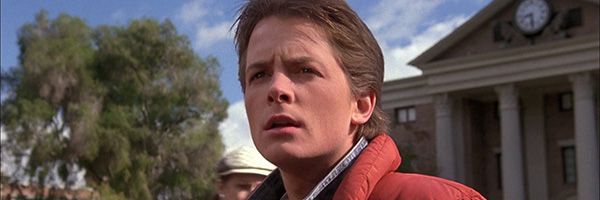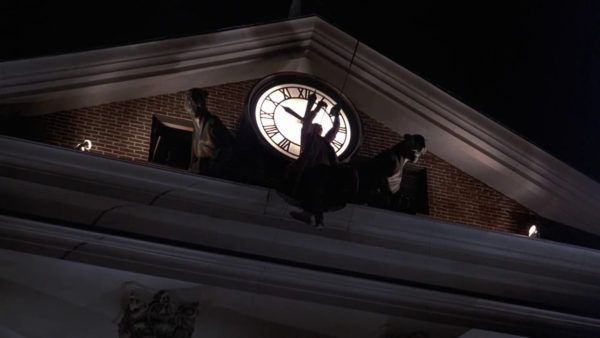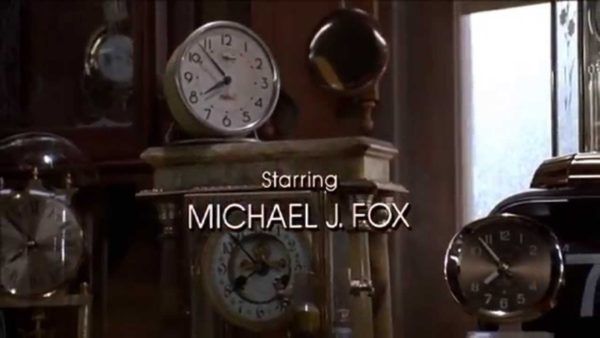The ending to Back to the Future is a truly iconic piece of filmmaking. Say the words “clock tower” to just about anyone and they’ll immediately think of the Back to the Future finale, in which Doc Brown (Christopher Lloyd) races against time to connect a cable to the clock tower in Hill Valley so Marty (Michael J. Fox) can drive his DeLorean back to the future. But this clock tower ending almost never happened, as writers Robert Zemeckis and Bob Gale originally had a completely different ending for the film in mind – one that would serve as inspiration for a key plot point in an Indiana Jones sequel years later.
Gale recently joined us on The Collider Podcast to talk about the Back to the Future trilogy in anticipation of the franchise’s release on 4K on October 21st, and during our interview Gale revealed the Back to the Future original ending and why it was scrapped. Indeed, Gale said that in the first iteration of the film’s script, the finale took place on a nuclear test site:
“The idea that the DeLorean was nuclear powered, literally they needed to harness nuclear energy to send the time machine back to the future. Bob [Zemeckis] and I had seen The Atomic Café documentary, a movie called The Atomic Kid which we pay homage to on the marquee of the town theater in 1955 – one of the most perverse movies ever made… We were obsessed with the idea of ‘Hey wouldn’t it be cool if we could recreate one of these towns and blow it up?’ And you know, hey, okay yeah you’re a writer, you can write anything in the script that you want. So we wrote this elaborate sequence in and in the original version, the time machine was built into a refrigerator which was a time chamber. And that was where Marty was gonna be when the nuclear blast went off.”
But fairly early in the film’s development phase, the studio asked Zemeckis and Gale to trim the budget, and they had to scrap the most expensive sequence in the film – the finale.
“When it came time to cut the budget – and this was before we cast Eric Stoltz – the studio said, ‘Hey you guys can make the movie, but cut $1 million out.’ Bob and I looked long and hard at the script and said, ‘What do we cut? How do we save $1 million?’ And the most expensive thing was going on location and building this town. And we said well, if we can cut that out – if we can cut going on location and building a town and do something on a location that we already have, namely the backlot, that would save us $1 million easy. Over a weekend we spent time walking around on the backlot going back and forth to our offices, and we came up with the whole clock tower sequence. Flash forward to Indiana Jones 4 and you’ll see that Steven Spielberg was inspired by the original ending to Back to the Future.”
You may or may not know that throughout the long development process for Indiana Jones 4 and through multiple drafts of the script, one key element that Spielberg wanted to include was Indiana Jones surviving a nuclear blast inside a refrigerator. And as Spielberg was a producer on Back to the Future, clearly he sparked to this original ending idea and kept it in his back pocket for use years later in Kingdom of the Crystal Skull.
But the ending wasn’t the only part of the original Back to the Future that changed. Gale also revealed that as a result of recasting the role of Marty McFly five and a half weeks into filming (Eric Stolz was replaced by Fox over creative differences), the studio requested further budget cuts. And this resulted in an elaborate opening sequence being scrapped in favor of the now-iconic opening shot inside Doc Brown’s laboratory:
“The original opening of the movie was not that great long tracking shot that we see in Doc Brown’s laboratory. We had this whole thing where Marty gets stuck in detention and he sets off the fire sprinklers in the classroom to get out of detention and escape to get to his audition, and we realized that that was an awful lot of shooting, an awful lot of logistics, and we didn’t need any of that. And it was a set that we hadn’t finished. So we thought to ourselves okay, let’s save some money, let’s not finish this set, let’s figure out how we can start the movie in a set that we already have. And we of course had Doc Brown’s lab, and that’s what we did, and of course it turned out to be way, way better than what we had in the script.”
So the next time you hear about budget troubles on some highly anticipated project, keep in mind the now-iconic opening and ending of Back to the Future were a result of the film’s budget being cut and Gale and Zemeckis finding creative solutions.
You can watch our full interview with Gale in the video below. The Back to the Future Trilogy releases on 4K on October 21st.
Adam Chitwood is the Managing Editor for Collider. You can follow him on Twitter @adamchitwood.



